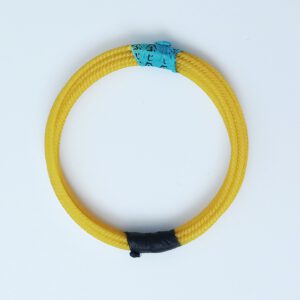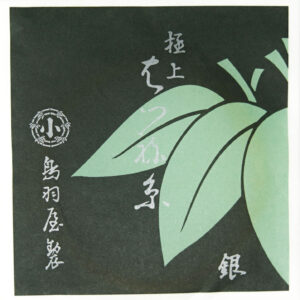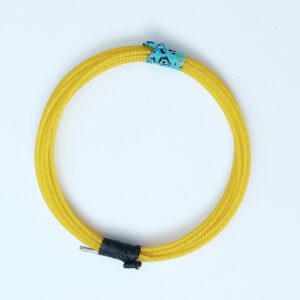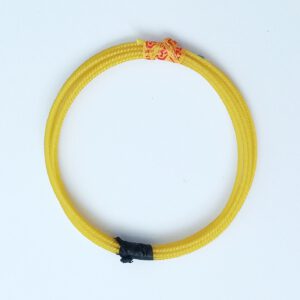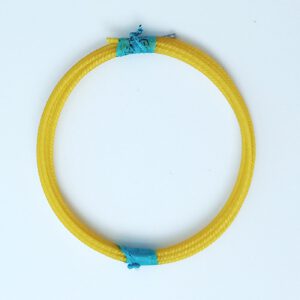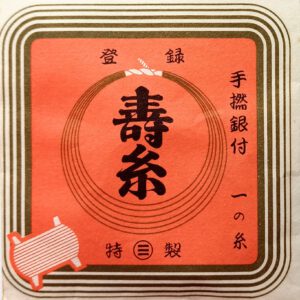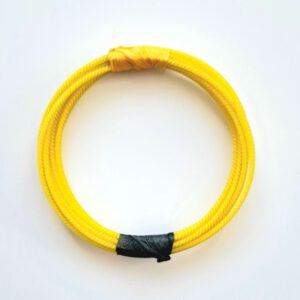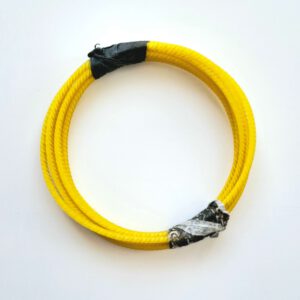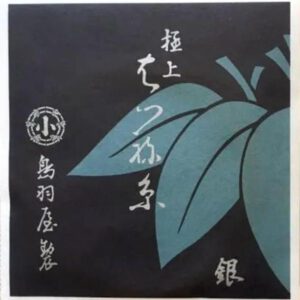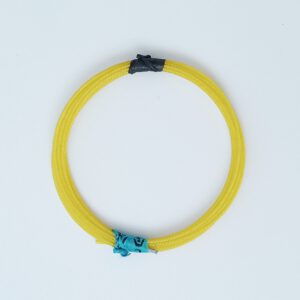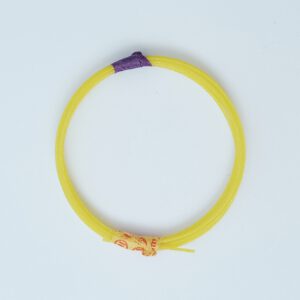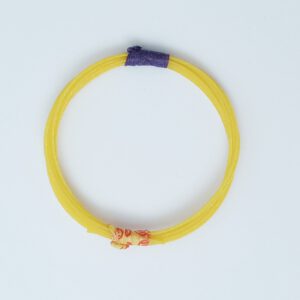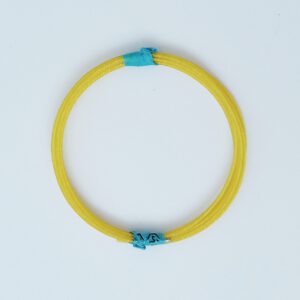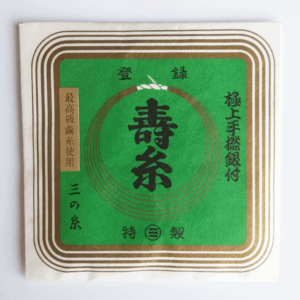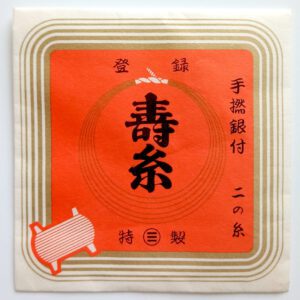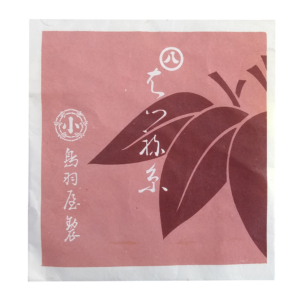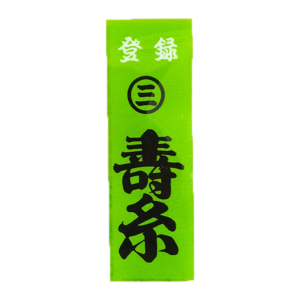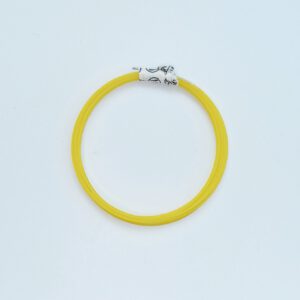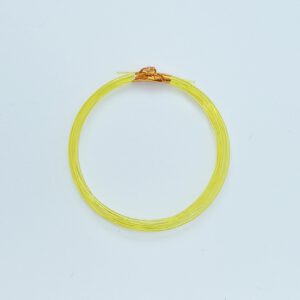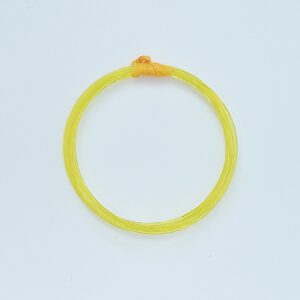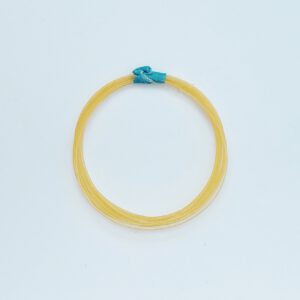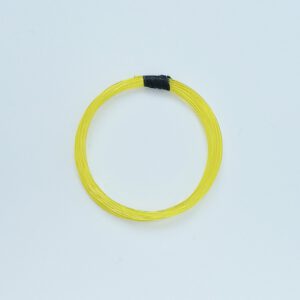STRINGS
Browse by
Choosing the Right String
The right string can make a difference. Depending on your instrument and the style you’re playing you can play around with the choice of strings to modify your instrument’s sound and feel. In general you want to choose a thinner string for a thinner neck and vice versa.
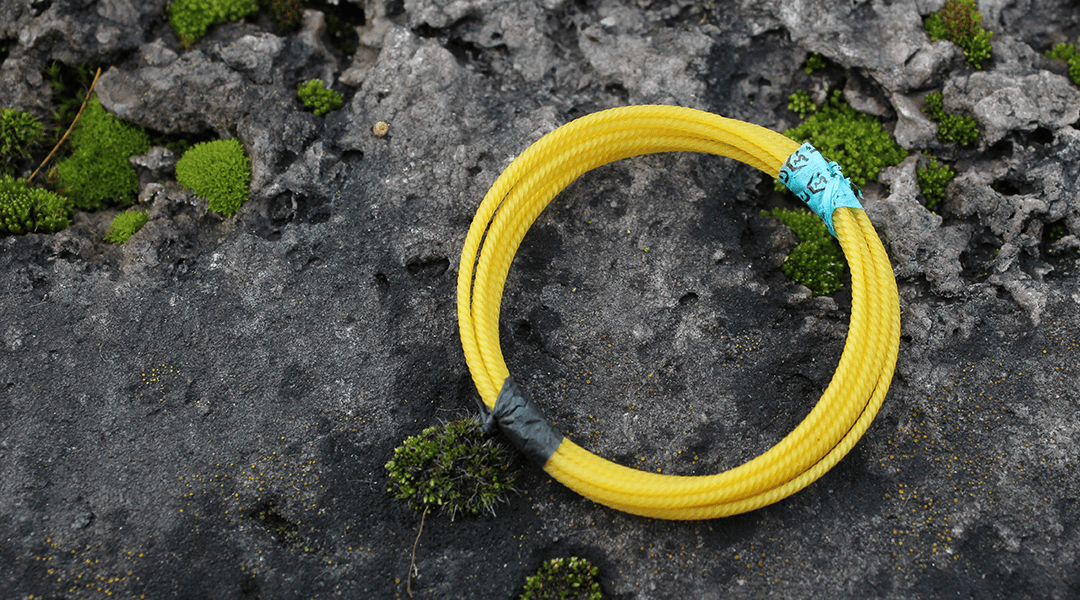
The Three Strings
There’s three different strings on the shamisen: thee think string ichi no Ito, the middle string ni no ito and the skinny string san no ito. Those names translate to 1st, 2nd, and 3rd string.
Cracking the Code
When purchasing a new string, you’ll notice that every string has a numeral code consisting of two numbers connected by a dash. The first number indicates the thread count. The second number indicates the string number (see above).
Thread Count
Each string comes in different thread counts. The higher the number the thicker the string. 14-3 for example is a pretty thick skinny string (san no ito).
String Gauge Guide
Depending on the style you’re playing, certain string gauge combinations are “common”. They reflect the predominate ideal sound aesthetic established in the different styles. Keep in mind that standards are not set in stone and that you can take the liberty to set your own preference in playing comfort and sound.
| Style | ichi no ito | ni no ito | san no ito |
| Nagauta | 15-1 | 13-2 | 13-3 |
| Kouta | 17-1 | 15-2 | 13-3 |
| Jiuta | 15-1 | 14-2 | 14-3 |
| Minyo | 17-1 | 14-2 | 13-3 |
| Tsugaru | 25-1 | 15-2 | 13-3 |
ICHI NO ITO | thick string
-
Ichi no Ito | Fuji Ito (silk) 25-1
6,85 € -
Ichi no Ito | Hatsune (silk) 18-1
6,00 € -
Ichi no Ito | Fuji Ito (silk) 15-1
6,50 € -
Ichi no Ito | Fuji Ito (silk) 17-1
6,50 € -
Ichi no Ito | Fuji Ito (silk) 18-1
6,50 € -
Ichi no Ito | Hatsune (silk) 17-1
6,00 € -
Ichi no Ito | Marusan Tokusei (silk) 18-1
6,39 € -
Ichi no Ito | Fuji Ito (silk) 24-1
6,85 € -
Ichi no Ito | Fuji Ito (silk) 28-1
7,35 €
NI NO ITO | middle string
-
Ni no Ito | Hatsune (silk) 13-2
4,95 € -
Ni no Ito | Fuji Ito (silk) 15-2
3,60 € -
Ni no Ito | Hatsune (silk) 15-2
4,95 € -
Ni no Ito | Marusan (tetron) 14-2
3,20 € -
Ni no Ito | Marusan (tetron) 15-2
3,20 € -
Ni no Ito | Fuji Ito (silk) 14-2
3,60 € -
Ni no Ito | Hatsune (silk) 16-2
4,95 € -
Ni no Ito | Marusan Gokujo (silk) 15-2
5,35 € -
Ni no Ito | Hatsune (silk) 14-2
4,95 € -
Ni no Ito | Marusan Gokujo (silk) 13-2
4,95 € -
Ni no Ito | Marusan Tokusei (silk) 15-2
4,65 € -
Ni no Ito | Marusan Tokusei (silk) 14-2
4,65 €
SAN NO ITO | skinny string
-
San no Ito | Hatsune (silk) 15-3
2,95 € -
San no Ito | Hatsune (silk) 12-3
2,85 € -
San no Ito | Marusan (nylon) 12-3
1,85 € -
San no Ito | Marusan Gokujo (silk) 14-3
2,95 € -
San no Ito | Marusan (silk) 14-3
2,55 € -
San no Ito | Fuji Ito (nylon) 13-3
1,65 € -
San no Ito | Fuji Ito (nylon) 12-3
1,65 € -
San no Ito | Hatsune (silk) 13-3
2,85 €
A Matter of Style? Silk vs. Synthetic
Traditionally, shamisen strings are made of silk. The most authentic sound, if you want to call it that, will be achieved with silk strings.
Silk strings provide a warm tone, which is especially pleasant when playing in traditional ensembles with Shakuhachi and Koto.
The downside of silk strings is the shorter lifespan compared to synthetic strings. Players will often practice with nylon or tetron strings and string their instrument with silk strings for a performance. But there’s nothing wrong with using silk strings for practice, too, because you, the player, will always treasure the subtle differences in your instrument’s sound the most.
Check out this interesting article on the art of silk string making.
Synthetic strings for shamisen have a full tone and are ideal for practice and play due to the material’s durability. Compared to silk strings, the tone is more crisp and the feel can be a bit tighter on your fingers. Try both materials to compare the unique qualities of the traditional silk strings and the modern and more durable synthetic option.
The strings come in different weights/thread thicknesses. The bigger the number the thicker the string. What kind of string is best for you depends on the size of your instrument, your style of playing, the kind of songs you’re playing and, last but not least, personal preference for tone and feel.
As a rule of thumb, you want to user thinner strings for thinner necks (hosozao) and thicker strings for thicker necks (futozao).
SILK
-
San no Ito | Hatsune (silk) 15-3
2,95 € -
Ni no Ito | Hatsune (silk) 13-2
4,95 € -
San no Ito | Hatsune (silk) 12-3
2,85 € -
Ichi no Ito | Fuji Ito (silk) 25-1
6,85 € -
Ni no Ito | Fuji Ito (silk) 15-2
3,60 € -
Ichi no Ito | Hatsune (silk) 18-1
6,00 € -
Ni no Ito | Hatsune (silk) 15-2
4,95 € -
Ni no Ito | Fuji Ito (silk) 14-2
3,60 € -
Ichi no Ito | Fuji Ito (silk) 15-1
6,50 € -
Ichi no Ito | Fuji Ito (silk) 17-1
6,50 €
SYNTHETIC
-
San no Ito | Marusan (nylon) 12-3
1,85 € -
Ni no Ito | Marusan (tetron) 14-2
3,20 € -
Ni no Ito | Marusan (tetron) 15-2
3,20 € -
San no Ito | Fuji Ito (nylon) 13-3
1,65 € -
San no Ito | Fuji Ito (nylon) 12-3
1,65 € -
San no Ito | Marusan | (tetron) 12-3
2,00 € -
San no Ito | Marusan | (tetron) 13-3
2,25 € -
San no Ito | Fuji Ito (nylon) 14-3
1,65 €
Attaching strings to the neo
Brands with Tradition
The strings you can purchase at Shami-Shop are manufactured by the most important traditional string makers in Japan. All strings are of excellent quality and are the brands are trusted by professional performers, teachers, and students alike.
MARUSAN HASHIMOTO
-
San no Ito | Marusan (nylon) 12-3
1,85 € -
Ni no Ito | Marusan (tetron) 14-2
3,20 € -
Ni no Ito | Marusan (tetron) 15-2
3,20 € -
San no Ito | Marusan Gokujo (silk) 14-3
2,95 € -
San no Ito | Marusan (silk) 14-3
2,55 € -
San no Ito | Marusan Gokujo (silk) 15-3
2,95 € -
Ni no Ito | Marusan Gokujo (silk) 15-2
5,35 € -
San no Ito | Marusan | (tetron) 12-3
2,00 € -
San no Ito | Marusan | (tetron) 13-3
2,25 € -
San no Ito | Marusan Gokujo (silk) 12-3
2,95 € -
Ni no Ito | Marusan Gokujo (silk) 13-2
4,95 €
HATSUNE ITO
-
San no Ito | Hatsune (silk) 15-3
2,95 € -
Ni no Ito | Hatsune (silk) 13-2
4,95 € -
San no Ito | Hatsune (silk) 12-3
2,85 € -
Ichi no Ito | Hatsune (silk) 18-1
6,00 € -
Ni no Ito | Hatsune (silk) 15-2
4,95 € -
Ni no Ito | Hatsune (silk) 16-2
4,95 € -
San no Ito | Hatsune (silk) 13-3
2,85 € -
San no Ito | Hatsune (silk) 14-3
2,85 € -
Ni no Ito | Hatsune (silk) 14-2
4,95 € -
Ichi no Ito | Hatsune (silk) 17-1
6,00 € -
Ni no Ito | Hatsune (silk) 17-2
4,95 €
FUJI ITO
-
Ichi no Ito | Fuji Ito (silk) 25-1
6,85 € -
Ni no Ito | Fuji Ito (silk) 15-2
3,60 € -
Ni no Ito | Fuji Ito (silk) 14-2
3,60 € -
Ichi no Ito | Fuji Ito (silk) 15-1
6,50 € -
Ichi no Ito | Fuji Ito (silk) 17-1
6,50 € -
San no Ito | Fuji Ito (nylon) 13-3
1,65 € -
San no Ito | Fuji Ito (nylon) 12-3
1,65 € -
San no Ito | Fuji Ito (nylon) 14-3
1,65 € -
Ichi no Ito | Fuji Ito (silk) 18-1
6,50 € -
Ichi no Ito | Fuji Ito (silk) 24-1
6,85 € -
Ichi no Ito | Fuji Ito (silk) 28-1
7,35 €
